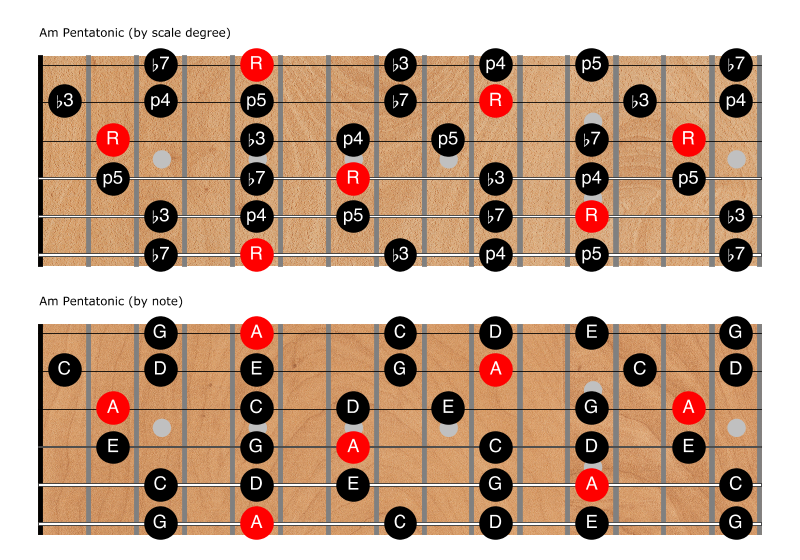Single octave
Introducing the frying pan
We’re now going to dive into our first scale, the Am Pentatonic scale. We will study this scale in depth, everywhere on the fretboard. It will soon be one of your best friends on the fretboard.
Here is the scale in all it’s glory. Believe it or not, you’ll soon be playing all these notes (and only these notes) without much mental effort:

Fig 1. The Am Pentatonic scale
Music comprises notes, harmony, and rhythm. The first two are built from scales.
Scales allow us to compose pleasing melodies, either pre-planned when song-writing, or on-the-fly while soloing. Scale notes are the ingredients for your melody.
A better analogy might be a painter’s palette: any song can use any note, but by restricting ourselves to a palette of fewer notes (a scale) it’s easier to create beautiful, harmonious melodies.
The scale we choose affects the overall sound/feeling/mood/color of a song.
Just as a painter might mix up a new color at any time, a talented musician can also make judicious use of notes outside the scale. Such notes add spice but are tricky to use well!
Scales also guide us when choosing chords and chord movements within a progression. They help lead us toward pleasing harmonies.
Like countless others, this course teaches Am pentatonic first. Am pentatonic is a good place to start for several reasons:
Pentatonic scales comprise just five notes. Five notes are easier to master than the seven notes in the parent diatonic scales.
Minor pentatonic scales often sound good over either minor or major chord progressions, especially Blues progressions. The converse is definitely not true, major pentatonic scales sound terrible over minor chord progressions.
It can be easily broken into five different shapes, one starting with each note in the scale.
The diatonic key of Am contains only “the white keys” on a piano. The white keys are the natural notes. Am pentatonic uses just five of those natural notes: A, C, D, E, and G. While the guitar fretboard doesn’t have “white keys,” most people do know the natural notes better than the sharps and flats.
Like any other complex task on guitar, we learn by breaking it into smaller, easier chunks. The trick is to thoroughly master each baby step. Don’t rush to complete each step, learn it forward and back, inside and out. Master each sub-step.
Introducing the frying pan
Frying pans in other octaves
Creating the blues scale
The first of five pentatonic shapes
Exploring the first three minor pentatonic “boxes”
Adding one More box
The final pentatonic box shape